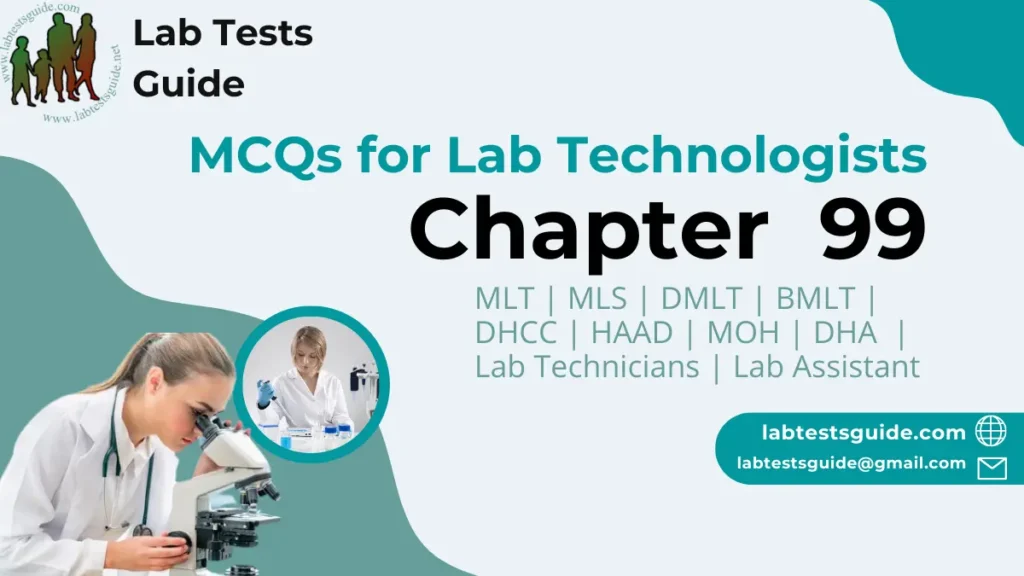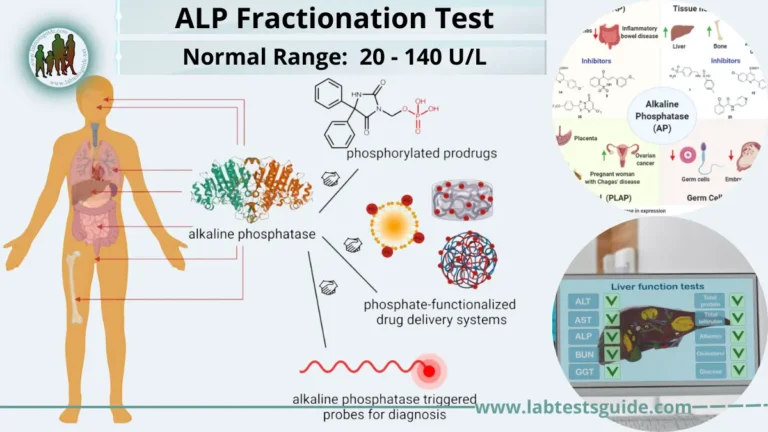4851 to 4900 MCQs for Lab Technician and Technologist Exam Preparation
5000 Plus MCQs for Lab Technician and Technologists are designed to test the knowledge and proficiency of laboratory professionals who work in the field of clinical laboratory science. These questions cover a wide range of topics related to laboratory science, including anatomy, physiology, microbiology, chemistry, and hematology.

If You like then share this to your friends and other social media.
If You have any question and suggestions then please Contact us Here
Questions 4851 to 4900
- Which of the following reactions is unique to gluconeogenesis?
- Lactate Pyruvate
- Phosphoenol pyruvate pyruvate
- Oxaloacetate phosphoenol pyruvate✔
- Glucose-6-phosphate Fructose-6-phosphate
- The synthesis of glucose from pyruvate by gluconeogenesis
- Requires the participation of biotin✔
- Occurs exclusively in the cytosol
- Is inhibited by elevated level of insulin
- Requires oxidation/reduction of FAD
- The conversion of pyruvate to acetyl CoA and CO2
- Is reversible
- Involves the participation of lipoic acid✔
- Depends on the coenzyme biotin
- Occurs in the cytosol
- Pasteur effect is
- Inhibition of glycolysis
- Oxygen is involved
- Inhibition of enzyme phosphofructokinase
- All of these✔
- How many ATPs are produced in the conversion of phosphoenol pyruvate to citrate?
- 1
- 2
- 4✔
- 6
- Reduced glutathione functions in R.B.Cs to
- Produce NADPH
- Reduce methemoglobin to hemoglobin
- Produce NADH
- Reduce oxidizing agents such as H2O2✔
- Phenylalanine is the precursor of
- L-DOPA
- Histamine
- Tyrosine✔
- Throxine
- D-Mannose is present in some plant products like
- Resins
- Pectins
- Mucilage
- Gums✔
- Galactose is a main constituent of
- Milk sugar✔
- Honey
- Cane sugar
- Chitin
- Glucosamine is an important constituent of
- Homopolysaccharide
- Heteropolysaccharide
- Mucopolysaccharide✔
- Dextran
- Glycogen is present in all body tissues except
- Liver
- Brain✔
- Kidney
- Stomach
- Iodine test is positive for starch, dextrin and
- Mucoproteins
- Agar
- Glycogen✔
- Cellulose
- The general formula for polysaccharide is
- (C₆H₁₀O₅)ₙ.✔
- (C6H12C6)n
- (C6H12O5)n
- (C5H10O5)n
- Epimers of glucose is
- Fructose
- Galactose✔
- Ribose
- Deoxyribose
- Human heart muscle contains
- D-Arabinose
- D-Ribose✔
- D-Xylose
- L-Xylose
- The intermediate n hexose monophosphate shunt is
- D-Ribulose✔
- D-Arabinose
- D-xylose
- D-Lyxose
- On boiling Benedict’s solution is not reduced by
- Sucrose✔
- Lactose
- Maltose
- Fructose
- The distinguishing test between monosaccharides and dissaccharide is
- Bial’s test
- Seliwanoff’s test
- Barfoed’s test✔
- Hydrolysis test
- Barfoed’s solution is not reduced by
- Glucose
- Mannose
- Sucrose✔
- Ribose
- Cori cycle is
- Synthesis of glucose
- reuse of glucose
- uptake of glycose
- Both (Synthesis of glucose) & (reuse of glucose)✔
- Cane sugar is known as
- Galactose
- Sucrose✔
- Fructose
- Maltose
- Which of the following is not reducing sugar?
- Lactose
- Maltose
- Sucrose✔
- Fructose
- α−D-Glucose and β−D-glucose are related by
- Epimers
- Anomers✔
- Multirotation
- Ketoenol pair
- The stable ring formation in D-Glucose involves
- C-1 and C-4
- C-1 and C-2
- C-1 and C-5✔
- C-2 and C-5
- Reduction of Glucose with Ca++ in water produces
- Sorbitol✔
- Dulcitol
- Mannitol
- Glucuronic acid
- Starch and glycogen are polymers of
- Fructose
- Mannose
- α−D-Glucose✔
- Galactose
- Reducing ability of carbohydrates is due to
- Carboxyl group
- Hydroxyl group
- Enediol formation✔
- Ring structure
- Which of the following is not a polymer of glucose?
- Amylose
- Inulin✔
- Cellulose
- Dextrin
- Invert sugar is
- Lactose
- Mannose
- Fructose
- Hydrolytic product of sucrose✔
- The carbohydrate reserved in human body is
- Starch
- Glucose
- Glycogen✔
- Inulin
- A dissaccharide linked by α-1-4 Glycosideic linkages is
- Lactose
- Sucrose
- Cellulose
- Maltose✔
- All proteins contain the
- Same 20 amino acids✔
- Different amino acids
- 300 Amino acids occurring in nature
- Only a few amino acids
- Proteins contain
- Only L- α – amino acids✔
- Only D-amino acids
- DL-Amino acids
- Both (Only L- α – amino acids) and (Only D-amino acids)
- The optically inactive amino acid is
- Glycine✔
- Serine
- Threonine
- Valine
- At neutral pH, a mixture of amino acids in solution would be predominantly:
- Dipolar ions✔
- Nonpolar molecules
- Positive and monovalent
- Hydrophobic
- All amino acids contain negatively charged side chains
- pH (isoelectric pH) of alanine is
- 6.02✔
- 6.6
- 6.8
- 7.2
- Sulphur containing amino acid is
- Methionine✔
- Leucine
- Valine
- Asparagine
- An example of sulphur containing amino acid is
- 2-Amino-3-mercaptopropanoic acid✔
- 2-Amino-3-methylbutanoic acid
- 2-Amino-3-hydroxypropanoic acid
- Amino acetic acid
- All the following are sulphur containing amino acids found in proteins except
- Cysteine
- Cystine
- Methionine
- Threonine✔
- An aromatic amino acid is
- Lysine
- Tyrosine✔
- Taurine
- Arginine
- The functions of plasma albumin are
- Osmosis
- Transport
- Immunity
- both (Osmosis )and (Transport)✔
- Amino acid with side chain containing basic groups is
- 2-Amino 5-guanidovaleric acid✔
- 2-Pyrrolidine carboxylic acid
- 2-Amino 3-mercaptopropanoic acid
- 2-Amino propanoic acid
- An essential amino acid in man is
- Aspartate
- Tyrosine
- Methionine✔
- Serine
- Non essential amino acids
- Are not components of tissue proteins
- be synthesized in the body from essential amino acids✔
- Have no role in the metabolism
- May be synthesized in the body in diseased states
- Which one of the following is semiessential amino acid for humans?
- Valine
- Arginine✔
- Lysine
- Tyrosine
- An example of polar amino acid is
- Alanine
- Leucine
- Arginine✔
- Valine
- The amino acid with a nonpolar side chain is
- Serine
- Valine✔
- Asparagine
- Threonine
- A ketogenic amino acid is
- Valine
- Cysteine
- Leucine✔
- Threonine
- An amino acid that does not form an αhelix is
- Valine
- Proline✔
- Tyrosine
- Tryptophan
- An amino acid not found in proteins is
- β-Alanine✔
- Proline
- Lysine
- Histidine
The questions are typically designed to assess the technical skills and knowledge required for the laboratory profession, including the ability to analyze laboratory test results, perform laboratory procedures, and maintain laboratory equipment.
To prepare for these MCQs, candidates should have a thorough understanding of the key concepts and principles of laboratory science. They should also be familiar with common laboratory equipment and procedures, as well as laboratory safety protocols.
Candidates may also benefit from studying specific laboratory science textbooks or taking online courses that cover the material tested in the MCQs. Additionally, practicing sample MCQs and reviewing the answers can help candidates identify areas where they may need to improve their knowledge or skills.
Overall, the MCQs for lab technologists are designed to be challenging and comprehensive, requiring candidates to demonstrate a high level of proficiency in the field of laboratory science.
Possible References Used







